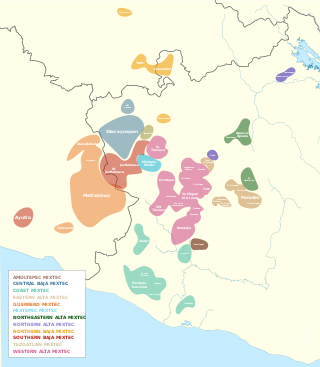This article should specify the language of its non-English content, using {{lang}}, {{transliteration}} for transliterated languages, and {{IPA}} for phonetic transcriptions, with an appropriate ISO 639 code. Wikipedia's multilingual support templates may also be used. (July 2021) |
| Mixtec | |
|---|---|
| Native to | Mexico |
| Region | Oaxaca, Puebla, Guerrero |
| Ethnicity | Mixtecs |
Native speakers | 530,000 in Mexico (2020 census)[1] |
Oto-Manguean
| |
| Latin | |
| Official status | |
Official language in | Mexico |
| Regulated by | Academy of the Mixtec Language Instituto Nacional de Lenguas Indígenas |
| Language codes | |
| ISO 639-3 | (fifty-two individual codes) |
| Glottolog | mixt1427 |
 Extent of the Mixtec languages: prior to contact (olive green) and current (red) | |
 The distribution of various Mixtec languages and their classification per Glottolog | |
| People | Mixtec ñuù savi, nayívi savi, ñuù davi, nayivi davi |
|---|---|
| Language | Mixtec sa'an davi, da'an davi, tu'un savi,.. |
| Country | Mixteca Ñuu Savi, Ñuu Djau, Ñuu Davi,.. |
The Mixtec (/ˈmiːstɛk, ˈmiːʃtɛk/)[2] languages belong to the Mixtecan group of the Oto-Manguean language family. Mixtec is spoken in Mexico and is closely related to Trique and Cuicatec. The varieties of Mixtec are spoken by over half a million people.[3][4] Identifying how many Mixtec languages there are in this complex dialect continuum poses challenges at the level of linguistic theory. Depending on the criteria for distinguishing dialects from languages, there may be as few as a dozen[5] or as many as fifty-three Mixtec languages.[6]
- ^ Lenguas indígenas y hablantes de 3 años y más, 2020 INEGI. Censo de Población y Vivienda 2020.
- ^ "Mixtec". Oxford English Dictionary (Online ed.). Oxford University Press. (Subscription or participating institution membership required.)
- ^ 2000 census; the numbers are based on the number of the total population for each group and the percentages of speakers given on the website of the Comisión Nacional para el Desarrollo de los Pueblos Indígenas, http://www.cdi.gob.mx/index.php?id_seccion=660, accessed 28 July 2008).
- ^ "Tabulados Interactivos-Genéricos". www.inegi.org.mx. Retrieved 2021-05-24.
- ^ "Western Baja Mixtec".
- ^ "Glottolog 4.4 – Mixtec".